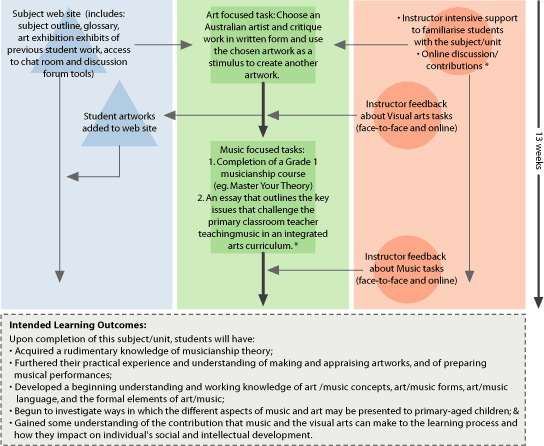|
SUPPORTS SUPPLIED
The main support mechanisms provided to students are:
Four discussion forums that each serves different social
and educational functions. There is a music forum and a visual
arts forum each supervised by different instructors. Apart
from this there is a general discussion forum that is more
focused on discussing issues as they relate more generally
to the role of the arts in education. A coffee shop forum
allows students to discuss more personal matters informally
and without the involvement of instructors. Students are able
to send private emails directly to other individuals via the
home page of the learning design web site.
The instructors play an important support role throughout
the course. Students receive a page of written feedback as
well as a grading in relation to each submitted assignment
from their instructors.
The same instructors direct workshops and lectures throughout
the residential school period.
Students are also encouraged to contact their instructors
if they wish to discuss any aspect of the course via the web,
private email, telephone, or fax.
The Teaching and Learning Center (TLC) at UNE provides a
general style guide to students for assisting in academic
writing in various formats. The Education Faculty at UNE also
produces a student booklet on academic literacies and this
provides students with a template for essay writing.
Reading material in the unit resource book outlines methods
for researching and writing about artists and artworks (as
required for assignment one).
There are guidelines written in the unit outline about how
to approach creating the required artwork. Art skills and
techniques are also demonstrated at the residential school.
A lecture, tutorial and notes on the topic of "issues
facing music teachers in primary schools" (assignment
two) is provided to students during the residential school.
A music theory book has structured sequential music exercises
that students must follow. An interactive music computer program
is recommended (and is on all UNE School of Education computers)
if students need assistance with the level one music theory
in the exercise book.
SIGNIFICANCE OF SUPPORT STRATEGIES
The significance of the learning design is that it breaks
down the isolation of the distance learner and creates an
environment where students can interact and collaborate. The
WebCT software is relatively easy to use and students haven't
experienced much difficulty accessing and using it. There
has been a good match between outcomes and assessment tasks.
SUPPORT STRATEGY ADAPTATION
It would be optimal if there was a greater reference through
online discussions to the printed reading materials provided
to students. More modelling of how to discuss issues and supervision
of the web site by instructors would enhance the quality of
learning. Possibly more conceptual and practical links could
be formed between the learning tasks, the residential school
work, and the resource materials to make the knowledge clearer
and more meaningful to students.
|
